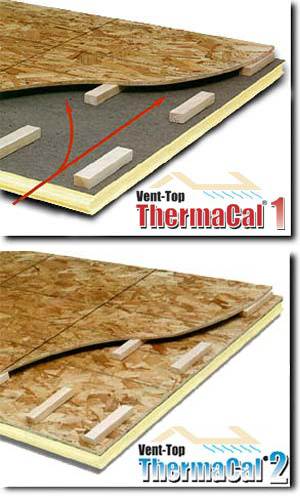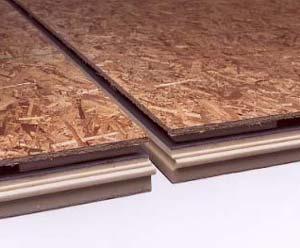

Ventilated Polyisocyanurate Roof Insulation Vent-Top ThermaCal is a ventilated nail base roof insulation which combines oriented strand board and polyisocyanurate foam. Vent-Top ThermaCal 1 has (1) layer of O.S.B. and Vent-Top ThermaCal 2 has (2) layers of O.S.B. The nail base is APA performance rated O.S.B. consisting of hardwood wafers bonded under heat and pressure with waterproof resin. 7/16" O.S.B. is standard and 5/8" or ¾” O.S.B. or plywood is available for special applications. Please see the attached Data Table for available sizes and performance data. USES, APPLICATIONS Vent-Top ThermaCal insulation is used when you want to insulate outside the structural roof deck. This occurs in many buildings with cathedral ceilings or where the attic is climate controlled to protect sprinklers and mechanical equipment. The roof deck may be steel, wood or concrete etc. Vent-Top ThermaCal 1 and 2 provide excellent insulation values combined with a ventilated area below the roof sheathing. 
This photograph shows the tongue and groove foam edges on four sides of our vented roof insulation. This is available when specified and will reduce the heat loss at the joints. The wood edges are cut back or rabbetted to allow for proper clearance at the panel edges. Re-Roofing – The application of asphalt shingles directly to insulated sheathing has contributed to many premature roof failures. Ventilated roof insulation is the solution to the ventilation problem when re-roofing buildings with cathedral ceilings. ADVANTAGES SHINGLE WARRANTIES - shingle manufacturers and the Asphalt Roofing Manufacturers Association require ventilation between the roof sheathing and any insulation. The lack of proper ventilation may void the shingle manufacturers warranty. See A.R.M.A. Tech. Bulletin 211-RR-94 (Copies available from Cornell Corp.). Ventilated Surface - Vent-Top ThermaCal provides the ventilated top surface that many contractors and shingle manufacturers require. In hot weather this cools the sheathing and shingles. It also allows any moisture to escape. In severe winter weather it provides a cold air space below the top sheathing. This cold roof reduces snow melting and the possibility of run off forming ice dams and causing leakage above the walls. Ventilated Space - The air space provides over 10 sq. in. of Net Free Area per lineal foot of Insulation after deducting for the spacer blocks. This gives 20 sq. in. of Net Free Area per lineal foot of ridge (insulation on both sides) and exceeds the standard 18 sq. in. per foot used in the ridge vent industry. The spacers are solid wood to resist compression and occupy only 8% of the panel area. They leave 50% open for lateral (across the slope) ventilation. This allows maximum air flow both up the slope and horizontally. UNDERWRITERS LABORATORIES CODES AND COMPLIANCES CODE ACCEPTABILITY CERTIFICATION Plastic foam must be protected from flame on the inside by a suitable barrier. Some codes required a 15 minute barrier. Generally, wood decking or drywall is acceptable and plywood or metal decking are allowed in certain roofing applications. CHECK LOCAL CODES. FEDERAL SPECIFICATION - meets the physical property requirements of HH-I-1971/GEN. The foam meets ASTM C1289-95. MODEL CODES - foam insulation is in compliance with: VENT SPACE PROPERTIES PHYSICAL PROPERTIES Foam:
SPECIFICATIONS TECHNICAL GENERAL OTHER PRODUCTS CORNELL CORPORATION |